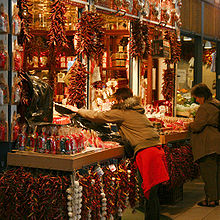- Paprika
-
For other uses, see Paprika (disambiguation).
Paprika is a spice made from the grinding of dried fruits of Capsicum annuum (e.g., bell peppers or chili peppers). In many European languages, the word paprika refers to bell peppers themselves. The seasoning is used in many cuisines to add color and flavor to dishes. Paprika can range from mild to hot. Flavors also vary from country to country.
Contents
Etymology
In modern times, the word paprika is derived from the Hungarian paprika or the Bosnian, Croatian and Serbian paprika [паприка];[1] meaning pepper (Capsicum). The Hungarian paprika is a diminutive form of the Bosnian/Croatian/Serbian/Montenegrin papar, derived from the Latin piper or Modern Greek piperi. It came into currency in the 19th century.[2] Many European languages use a similar word whilst examples from other languages include the Hebrew paprika [פפריקה] and the Japanese papurika [パプリカ].[1]
Usage
Paprika is produced in a number of places including Spain, Hungary, and California.[3] It is used as an ingredient in a broad variety of dishes throughout the world. Paprika is principally used to season and color rices, stews, and soups, such as goulash, and in the preparation of sausages as an ingredient that is mixed with meats and other spices. In the United States, paprika is frequently sprinkled on foods as a garnish, but the flavor is more effectively produced by heating it gently in oil.[4]
Spanish Paprika (Pimentón) is available in three versions, mild (Pimentón Dulce), moderately spicy (Pimentón Agridulce), and very spicy (Pimentón Picante.) Some Spanish paprika, including Pimentón de la Vera has a distinct smokey flavor and aroma as it is dried by smoking, typically using oak wood.[5]
Hungary is a major source of paprika and is thus more commonly used. It is available in grades ranging as follows:
- Special quality (Különleges) the mildest, very sweet with a deep bright red color.
- Delicate (csípősmentes csemege) – color from light to dark red, a mild paprika with a rich flavor.
- Exquisite Delicate (Csemegepaprika) – similar to Delicate, but more pungent.
- Pungent Exquisite Delicate (Csípős Csemege, Pikáns) - an even more pungent version of Delicate.
- Rose (Rózsa) – pale red in color with strong aroma and mild pungency.
- Noble Sweet (Édesnemes) – the most commonly exported paprika; bright red and slightly pungent.
- Half-Sweet (Félédes) – A blend of mild and pungent paprikas; medium pungency.
- Strong (Erős) – light brown in color, the hottest paprika.[6]
The Netherlands is a major production and distribution source of paprika as well, especially grown in greenhouses.
In Moroccan cuisine, paprika (tahmira) is usually found slightly moistened by the addition of a small amount of olive oil blended into it.
Paprika can also be used with henna to bring a reddish tint to hair when coloring it. Paprika powder can be added to henna powder when prepared at home.
Nutrition
Capsicum peppers used for paprika are unusually rich in vitamin C, a fact discovered in 1932 by Hungary's 1937 Nobel prize-winner Albert Szent-Györgyi.[7] Much of the vitamin C content is retained in paprika, which contains more vitamin C by weight than does lemon juice.[8]
Paprika is also high in other antioxidants.[9] Prevalence of nutrients, however, must be balanced against quantities ingested, which are generally negligible for spices.
The color of paprika is primarily due to the xanthophyll carotenoid zeaxanthin.
1tbsp of paprika contains the following nutritional information according to the USDA:[10]
- Calories :19
- Fat(g): 0.88
- Carbohydrates(g): 3.67
- Fibers(g): 2.4
- Protein: 0.96
See also
References
- ^ a b Katzer, Gernot (May 27, 2008). "Paprika (Capsicum annuum L.)". http://www.uni-graz.at/~katzer/engl/Caps_ann.html. Retrieved February 21, 2011.
- ^ "Online Etymology Dictionary". Etymonline.com. http://www.etymonline.com/index.php?term=paprika. Retrieved 2011-11-04.
- ^ "Paprika - Food Facts". Food Reference. http://www.foodreference.com/html/artpaprika.html. Retrieved 2011-11-04.
- ^ Hyde, Brenda. "Classic Spice Blends: Paprika". Oldfashionedliving.com. http://oldfashionedliving.com/paprika.html. Retrieved 2011-11-04.
- ^ "Spanish Paprika - Pimentón". Spanishfood.about.com. 2011-03-02. http://spanishfood.about.com/od/essentialingredients/a/paprika.htm. Retrieved 2011-11-04.
- ^ by Tom (2008-10-31). "Grades of Paprika | The Spice House Blog". http://blog.thespicehouse.com/grades-of-paprika/. Retrieved 2011-11-04.
- ^ ": Szeged, 1931-1947: Vitamin C, Muscles, and WWII:". The Albert Szent-Gyorgyi Papers. U.S. National Library of Medicine. http://profiles.nlm.nih.gov/WG/Views/Exhibit/narrative/szeged.html. Retrieved 2009-04-22.
- ^ "Nutrition Facts Comparison Tool: Spices Paprika v. Lemon Juice Raw". Healthaliciousness. 2009. http://www.healthaliciousness.com/nutritionfacts/nutrition-comparison.php?o=2028&t=9152&h=102&s=100&e=100&r=. Retrieved 2009-07-27.
- ^ "Oxygen Radical Absorbance Capacity (ORAC) of Selected Foods – 2007", United States Department of Agriculture, November 2007.
- ^ http://www.nal.usda.gov/fnic/foodcomp/search/
External links
Capsicum cultivars C. annuum Aleppo · Anaheim · Ancho · Banana pepper · Bell pepper · Cascabel · Cayenne · Chilaca · Chiltepin · Cubanelle · De árbol · Dundicut · Fresno · Guajillo · Hungarian wax · Italian sweet · Jalapeño · Mirasol · Macho · Mulato · New Mexico (Anaheim) · Paprika · Pasilla · Peperoncini · Peter · Piquín · Pimento · Poblano · Puya · Serrano · Shishito · Tien TsinC. chinense Adjuma · Ají Limo · Ají dulce · Datil · Fatalii · Habanero · Hainan Yellow Lantern Chili · Madame Jeanette · Naga Jolokia · Red Savina Habanero · Scotch bonnetC. frutescens C baccatum C. pubescens Categories:- Spices
- Chili peppers
- Medicinal plants
- Hungarian loanwords
- Hungarian cuisine
- Bosnia and Herzegovina cuisine
- Bulgarian cuisine
- Serbian cuisine
- Spanish cuisine
- Portuguese cuisine
- Serbian loanwords
- Puerto Rican ingredients
- Macedonian cuisine
Wikimedia Foundation. 2010.




